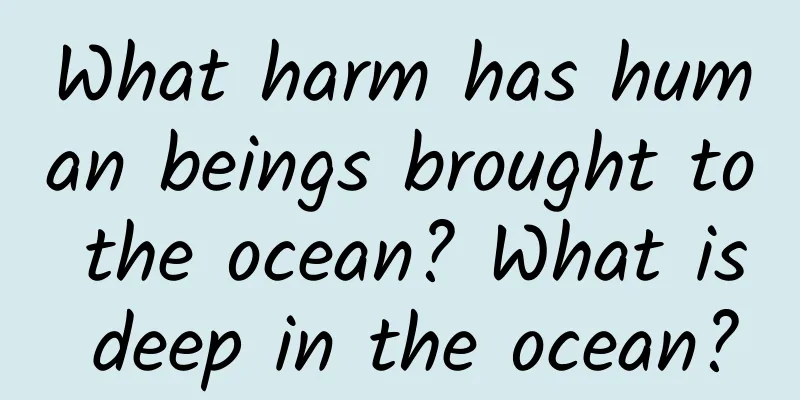What harm has human beings brought to the ocean? What is deep in the ocean?

|
Substances or energy that enter the marine environment directly or indirectly through human activities and can have harmful effects. The man-made pollutants accumulated in the ocean are not only numerous in variety and quantity, but also have far-reaching harm. Marine animals are generally the same in all oceans of the world, which shows that the oceans are interconnected and marine animals can interact with each other. Therefore, we should protect marine resources even better. Contents of this article 1. What harm has human beings brought to the ocean? 2. What is in the deep ocean? 3. What are the four major oceans in the world? 1What harm has human beings brought to the ocean?The harm that humans bring to the ocean: 1. Overfishing. Marine biodiversity is of great importance to human survival, but it is facing increasing danger. The depletion of fisheries is one of the most concerning issues. 2. Human activities pollute the ocean and harm marine life. Substances or energy that enter the marine environment directly or indirectly due to human activities and can have harmful effects. People can pollute the ocean by discharging sewage at sea and in coastal areas, and sewage dumped in inland areas can also enter the ocean through atmospheric transport and river carrying. The man-made pollutants accumulated in the ocean are not only numerous in variety and quantity, but also far-reaching in their harm. 2What's in the Deep Ocean?1. There should be a relatively independent biological world in the deep ocean. 2. The trench is the deepest place in the ocean and also a place with a very unique marine environment. Within the depth of 3,600 meters, the marine animals in the world's oceans are generally the same, which shows that the oceans are interconnected and marine animals can travel with each other. At deeper seabeds, the creatures in different sea areas are different, and in the trenches, they have their own unique fauna. 3. This shows that today's deep-sea trenches were once relatively shallow. During the process of the trenches sinking and deepening, many marine animals were trapped in the abyss, isolated from the outside world. Some animals were eliminated, while others adapted to the environment of the abyss and maintained their past shapes. In this way, the trenches have preserved special animals left over from ancient times. Therefore, the study of various organisms in the trenches can help us understand the history of the ocean. 3What are the four major oceans in the world?Pacific Ocean: The largest ocean on Earth, it covers about 46% of the Earth's surface and about 32.5% of the total area. It is the largest, deepest and most island-rich ocean on Earth, accounting for 1/3 of the Earth's total surface area. Arctic Ocean: It is the smallest, shallowest and coldest ocean in the world, and the smallest of the four oceans on Earth. The Arctic Ocean is roughly centered on the Arctic Circle, between Asia, Europe and the northern coast of North America. It is located at the northernmost tip of the Earth, surrounded by the European and North American continents, and connected to the Pacific Ocean by the narrow Bering Strait; it is connected to the Atlantic Ocean through the Greenland Sea and many straits, with an area of 15 million square kilometers, a depth of 1,097 meters, and a maximum depth of 5,499 meters. The ancient Greeks once called it "the ocean opposite the Big Dipper." Indian Ocean: Located between Asia, Oceania, Africa and Antarctica, it is the third largest ocean in the world, with India, Pakistan and Iran to the north and the Arabian Peninsula and Africa to the west. Atlantic Ocean: The world's second largest ocean, located between Europe, Africa, North and South America and Antarctica. |
>>: Are there mermaids in the world? What kind of animal are mermaids?
Recommend
How many minutes does it take to make popcorn in an air fryer? What is the long hollow popcorn called?
Popcorn is not only crispy, but also can be made ...
How to eat peach gum? Does peach gum have to be boiled for 30 minutes?
Peach gum is also known as peach blossom tears. T...
What is the most effective method for treating pelvic inflammatory disease?
Under the current social conditions, the harm of ...
Pregnancy after ejaculation outside the ovulation period
The ovulation period can be said to be a dangerou...
What causes pain around the breast?
Breasts are a very important part of women. On th...
How to permanently remove a woman's beard
It is not common for women to grow beards in real...
What are the exercises for vaginal relaxation?
I believe that many married female friends have s...
Will I still have my period if I'm pregnant?
The most direct symptom of pregnancy is amenorrhe...
Suggested to save! Keep this acne-fighting guide and it will turn you from an acne-fighter into an acne-victor!
When we reach puberty, the thing that best proves...
Sudden discharge of brown discharge
Female secretions should be milky white or transl...
What are the examination items during the second trimester?
Prenatal check-up is an essential part of pregnan...
9 health tips to keep away from gynecological diseases
Gynecological diseases are common diseases that p...
What is vaginal ulcer?
Women's private hygiene care is very importan...
What to do if you feel like you are not ovulating
In life, many women suffer from the phenomenon of...









